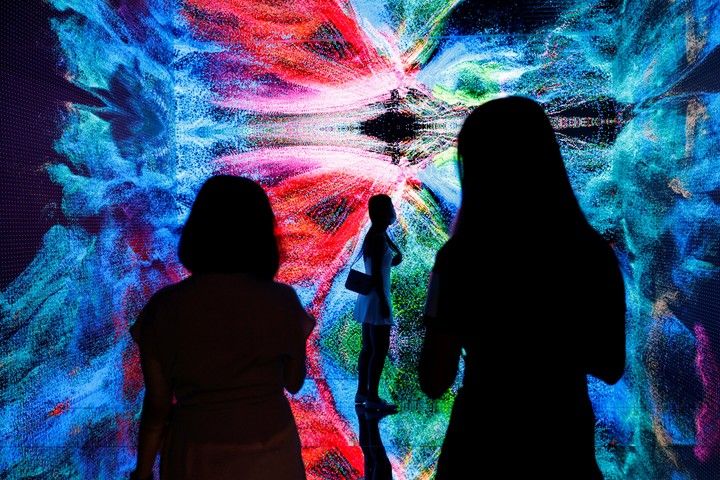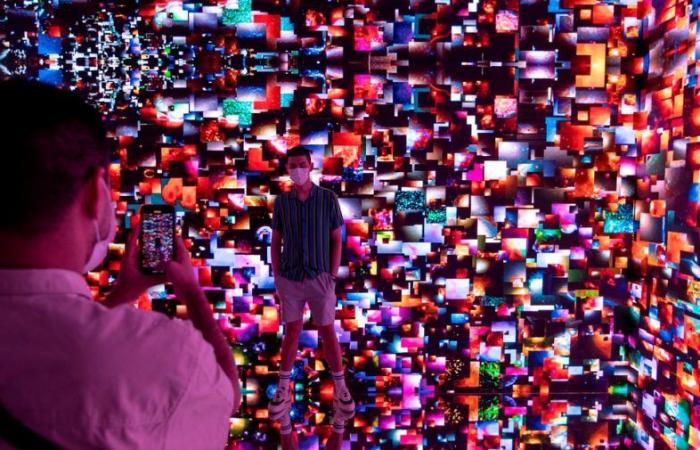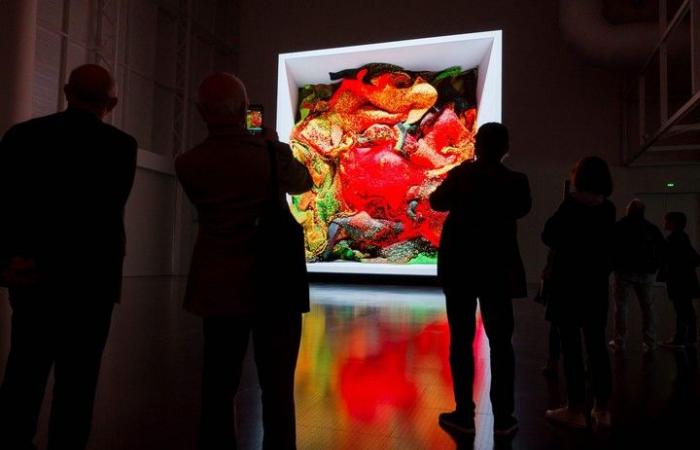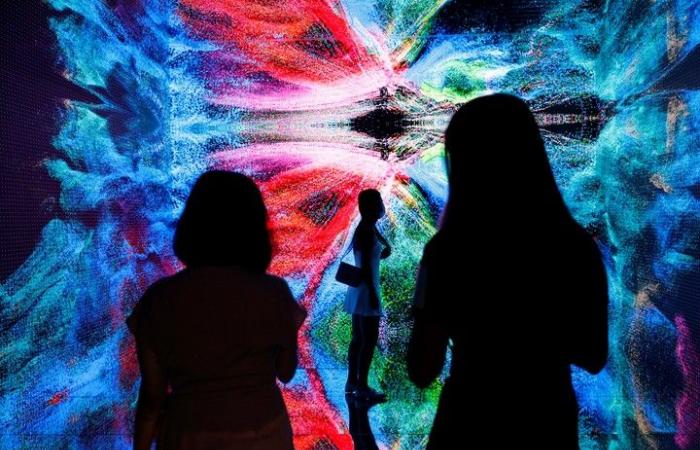The skeleton appears to be at the epicenter of a puzzling ritual. In a new work by French artist Pierre Huyghe, robots equipped with artificial intelligence film the unburied remains of a man and periodically bring objects to them in a ceremony that only they seem to understand. The scene takes place in the Atacama Desert (Chile), one of the oldest and arid deserts on the planet.
Camata can be seen in the Punta della Dogana exhibition space – Pinault Collection, in a sample that coincides with the Venice Biennale (which will run until November 24). It’s a poignant example of the growing overlap between art and artificial intelligence, or AI.
These two vowels, side by side, seem to represent a threat to many disciplines whose professionals risk being replaced by intelligent and autonomous machines. At some future time, humanity itself could be replaced by superintelligent machinesaccording to some world-renowned thinkers and philosophers, such as Israeli historian Yuval Noah Harari and Stephen Hawking.
Why do artists venture into artificial intelligence? Are they at risk of being extinguished by it?
Attraction by chance
“Artists have always been attracted to chance: something that is outside our control, something that frees us from the finite subject,” he said. Daniel Birnbaum, curator and artistic director of the digital art production platform Acute Art and panelist at the Art for Tomorrow conference convened this week in Venice by the Democracy & Culture Foundation with panels moderated by journalists from The New York Times.
Birnbaum said Huyghe was one of the artists who – instead of “overwhelming us with AI-generated nonsense on the internet” – are interested in exploring “places where nature and artificiality merge,” and where “biological systems and artificial systems collaborate in some way, creating visually strange things.”
In the world at large, Birnbaum acknowledged, there are “scary scenarios” in which artificially intelligent systems could control decisions made by governments or militaries and pose serious threats to humanity.
In the creative industries, he added, a number of ventures could soon be carried out by machines that would combine the best examples of human creations and generate remodeled versions of them. This could be conceivable in the case of quick-hit pop tunes, hastily produced commercial literature, the content of airline magazines, and “mediocre” architecture and design, she noted.
However, Birnbaum said, In the case of art, the public would continue looking for the metaphorical hand of the artist. “You just want to see this human participant” and detect traces of the artist’s “here and now,” where human and machine “touch,” she explained.
Controlled screens
One of the best-known artists in the field of AI-generated art is the Turkish Refik Anadol. She rose to global fame in late 2022, when set up an installation of computer-controlled screens in the lobby of the Museum of Modern Art in New York composed of more than 138,000 images and texts from MoMA’s public archive, which was in operation for almost a year.
This year, Anadol attracted 66,000 visitors in 47 days to Echoes of the Earth: Living Archivean exhibition at London’s Serpentine Galleries in which he showed AI-generated works depicting underwater landscapes and rainforests. The underwater landscapes were generated by an AI model based on some 135 million images of corals with open access online.
The rainforest images were produced by another AI model fed with freely available data from the Smithsonian Institution and the Natural History Museum in London.
Everything was part of the Anadol global project to make the invisible visible: demystifying AIshow where the data it uses comes from, and trace the origin of the rustling, billowing images audiences see on the screen.
In a video interview from his Los Angeles studio, Anadol defined himself as a “computer-loving nerd” whose mother gave him a Commodore when he was 8 years old and who, from that moment on, began to “understand and relate to a machine as if it were a friend, a co-creator, a collaborator.”
 This photo taken on June 9, 2022 shows “Machine Hallucinations. Reve de nature” by Turkish multimedia artist, director and pioneer in the aesthetics of machine intelligence Refik Anadol at the Pompidou-Metz museum, in Metz, northeastern France , from June 11, 2022 to August 29, 2022. (Photo by JEAN-CHRISTOPHE VERHAEGEN / AFP)
This photo taken on June 9, 2022 shows “Machine Hallucinations. Reve de nature” by Turkish multimedia artist, director and pioneer in the aesthetics of machine intelligence Refik Anadol at the Pompidou-Metz museum, in Metz, northeastern France , from June 11, 2022 to August 29, 2022. (Photo by JEAN-CHRISTOPHE VERHAEGEN / AFP) Said AI was “the most inspiring technology” that humanity has at its disposal today, and added: “We are experiencing a renaissance.
Anadol assured that every artist wants to see “what lies beyond reality” and “perceive worlds that do not exist.” AI is a vehicle for imagination that, he said, could represent “hallucinations, dreams, fantasies.”
The technology we face today is no longer “just a pen or a printing press,” nor “just a car or a wheel.” “It’s intelligence,” he said. “At the moment it imitates our reasoning and it will evolve. It will become something else.”
And that “has never happened in our history.”
Half and half
Currently, he explained, AI is “50% human, 50% machine.” In the future, he said she, AI will be “designed from the ground up: to see, to hear, to feel”, and to produce “a living form of art” that will be “a synthetic being.” He explained that artificial intelligence will take “archives of humanity and what we are leaving behind” – not just an image, a text or a sound, but “the smell, the taste, the touch” – and convert them into data and memory. with which you can create art.
 A visitor in front of an immersive art installation titled “Machine Hallucinations – Space: Metaverse”, by multimedia artist Refik Anadol, which will become an NFT and be auctioned online at Sotheby’s, at the Digital Art Fair, in Hong Kong, China , on September 30, 2021. REUTERS/Tyrone Siu
A visitor in front of an immersive art installation titled “Machine Hallucinations – Space: Metaverse”, by multimedia artist Refik Anadol, which will become an NFT and be auctioned online at Sotheby’s, at the Digital Art Fair, in Hong Kong, China , on September 30, 2021. REUTERS/Tyrone Siu defined AI as “a thinking brush that does not forgetwhich can remember anything and everything,” and said that he would “invite that AI into my studio, and I would embrace it and co-create” with it. “I will accept that AI as a human being,” he said.
The exhibition Echoes of the Earth arose from an invitation from the artistic director of the Serpentine Galleries, Hans Ulrich Obrist, to Anadol to exhibit there.
In an interview in his office on the Serpentine, Obrist recalled that in October 2011, after giving a talk in Marrakech, Morocco, he was approached by a London artist and technologist who told him that he did not understand why museums did not interact with the technology nowhere except on your website. Days later, Obrist brought together the artist and a group of people for a roundtable breakfast and, in 2013, created the technological division of the Serpentinewhich today has five curators.
Obrist said he realized that technology had to be integrated into exhibitions, “that the future might not actually be one thing or the other, that is, the idea that we have physical things in the gallery and digital things online, but that the future is a mixed reality.” He said AI art currently consists of collaborations between artists and machines; both participate.
He recalled that during Ian Cheng’s exhibition at the Serpentine in 2018, Cheng filled it with a sensitive piece of art called “BOB (Bag of Beliefs)”: On-screen digital creatures that had moods and minds of their own.
A call at dawn
During the exhibition, the Royal Parks security team (the Serpentine is in Kensington Gardens, part of London’s Hyde Park) once woke up Obrist at 4 in the morning because the lights had suddenly turned on in the middle of the night: BOB had decided to open the gallery long before the authorized time.
 Visitors in front of an immersive art installation titled “Machine Hallucinations – Space: Metaverse” by multimedia artist Refik Anadol, which will be turned into an NFT and auctioned online at Sotheby’s, at the Digital Art Fair, in Hong Kong, China, on September 30, 2021. REUTERS/Tyrone Siu
Visitors in front of an immersive art installation titled “Machine Hallucinations – Space: Metaverse” by multimedia artist Refik Anadol, which will be turned into an NFT and auctioned online at Sotheby’s, at the Digital Art Fair, in Hong Kong, China, on September 30, 2021. REUTERS/Tyrone Siu Obrist also recalled a comment in the guest book in which people had written that BOB had been “so unfriendly and inhospitable to them that they came back,” and they were “very grateful that BOB had been nice to them the second time.” .
Obrist said the idea of ”the work of art as a living organism” could open up “all kinds of possibilities.”
Until now, he notedworks of art have been immutable and etched in stone; even video or film-based installations have traditionally been played in pre-programmed loops. He recalled how, as a young man, he always saw the same two public sculptures every time he passed by the train station in Zurich, where he grew up. Letting AI take the lead in shared spaces ‘could create a new form of public art’, he claimed. “It is an evolution, it lives, it changes, it is never the same twice.”
He recognized the risks related to AI at a planetary level. He said there is a danger of it “getting out of control,” and that AI needs to be managed on a global scale. He noted that there has to be “consensus between East and West” and “boundaries that have to be set” to ensure that humanity is not in danger.
But, in terms of art, there are “very positive aspects in the current evolution,” he concluded.
© The New York Times / Translation: Elisa Carnelli










